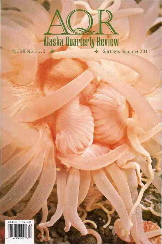The latest Alaska Quarterly Review (spring & summer 2011 issue) is now available, with another fabulous cover photo (by Clark James Mishler) and a stunning collection of contemporary literary writing.
One of AQR’s trademarks has become the inclusion of “special features”—sometimes long or hard-to-categorize works, sometimes thematic anthologies. For this issue, the very special feature is a play written by Alaskan Susie Silook. Silook, who is originally from Gambell on St. Lawrence Island, is best known as a visual artist whose full-tusk ivory carvings of women’s figures are treasured museum pieces. “Ungipamsuuka: My Story” is a memoir told in dramatic form, with narrator “Susie” presenting her life’s story with a cast of earlier versions of herself, family members, and other “characters” from her life.
This literary work originated with the Alaska Native Heritage Center’s Alaska Native Playwrights Project , which selected ten Alaska Natives for mentoring with theatre professionals. The resulting plays were given staged readings at Cyrano’s in Anchorage last November. For more about the project see http://www.firstalaskansmagazine.com/index.php?issue=02-2011&story=plays.
Plays, as theatre art, are ephemeral, and it’s a terrific thing that the editors at AQR saw fit to publish “Ungipamsuuka: My Story.” This is an unusual play, given its large cast of characters who appear in small roles and the memoiristic nature of it, with the main character identified with the author; the connections to oral history as part of Native culture are apparent, with that tradition adapted to a western literary form. But above all, this is a powerful work, as forthright for addressing uncomfortable issues as Silook’s sculptures—images of which are creatively incorporated into the play. The play exposes cultural loss and various abuses—but is ultimately about resilience and triumph of the human spirit. It should be read widely.
The other great strength in this AQR issue lies in the nonfiction section. Judging by the selections here, literary nonfiction and essays are thriving and fabulously varied. This section could be particularly instructive for writers because it showcases a number of different forms. “Gloria,” by John Picard, is an outstanding work that both details a family tragedy and effectively and creatively imagines additional events. “Fog,” by Bill Capossere, is a lovely segmented meditation on its subject. A third piece, Yelizaveta P. Renfro’s “Quercus,” is in the form of a “braided” essay. (A writing strategy I’ve both used and taught involves taking two separate narratives—especially when neither one fully works on its own—and intertwining them in alternate sections. I can’t know whether “Quercus” originated in this way, but I can imagine that it might have been; its two seemingly unrelated story lines wind together into an unexpected completeness.)
I was personally less taken with the fiction and poetry in this volume, although I was incredibly impressed with the short story, “A Man Who Is Too Good,” by Richard Alwan. In this very skillful and complex story, the main character references the events of his life through movies. It’s especially pleasing to note that the story is Alwan’s first published in a national literary magazine. AQR prides itself on publishing first-time writers; here’s proof that they find the gold.
Are you wondering what it takes to break into a first-rate journal like AQR—and how to prepare and submit work? A 49 Alaska Writing Center class taught by long-time AQR editor Ronald Spatz will be offered on March 26. See also a recent interview with Spatz.

